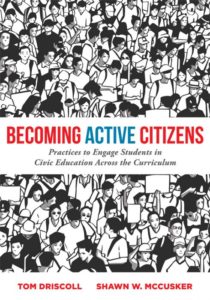What Students Need in Civic Education Now
Becoming Active Citizens: Practices to Engage Students in Civic Education Across the Curriculum
By Tom Driscoll and Shawn W. McCusker
(Solution Tree Press, 2022 – Learn more)
Reviewed by Sarah Cooper

According to Tom Driscoll and Shawn W. McCusker in Becoming Active Citizens: Practices to Engage Students in Civic Education Across the Curriculum, “By 2016, the fractured and polarized nature of modern politics had become a crisis, and there was a renewed interest that focused attention on the topic of civic education again. For some, the acrimony and hostility among not just elected officials but the American populace were a Sputnik moment for civic education that demanded immediate action.”

As one indication of the book’s immediate practical impact: Just after finishing Becoming Active Citizens, I recommended it to several of my middle and high school social studies colleagues and added a few of its activities to an opening unit on media literacy in 8th grade U.S. history and civics.
An appealing incremental approach recurs throughout the chapters, creating a soothing narrative for teachers who don’t feel they can do it all at once but could certainly try one or two new things: “Any steps you can take in your classes and your curriculum to enhance students’ learning experiences can make a tremendous impact on their trajectory,” the authors write.
“Collectively, improvement in civics instruction will ultimately strengthen the health of democratic societies and their institutions. The work is difficult and humbling, but well worth it.”
Part I: The State of Civic Education
The introduction and first two chapters of the book, “How Schools Provide Civic Education” and “What Works in Civic Education,” build a powerful case for the need to teach civics. Here you’ll discover statistics such as “In the United States, 70 percent of students will never write a letter, share an opinion, or help solve a problem as part of their civic education” and “in 2019, only 29 percent of Americans could name all three branches of government, and 25 percent couldn’t name even one.”
The authors thoroughly survey the research about creating citizens, providing multiple views on best practices. Afterward comes a series of helpful implementation strategies:
- Courses on Civics, Government, Law and Related Topics
- Deliberations of Current, Controversial Issues
- Service Learning
- Student Voice in Schools
- Simulations of Adult Civics Roles
- High-Quality News Media Literacy Education
- Specific Focus on Action Civics
- Increased Focus on Social-Emotional Learning
- School Climate Reform
Part II: Modern Civics in Action
If Part I offers a call to action, Part II lines up the marching orders to meet that call. Here is a sampling of its ideas:
Chapter 3, The Power of Action Civics and Authentic Experiences
“Educators who advocate for action civics tend to encourage students to identify societal problems and design public policy solutions to address them,” using programs such as Generation Citizen, Mikva Challenge, Project Citizen and Earth Force.
In addition, “action civics has significant overlap with other concepts, such as service learning, project-based learning, experiential learning, and others” and can also lead to deeper learning.
Chapter 4, Engagement in Civil Discourse
“To fulfill their important role in society, schools and teachers need to run to – not from – the challenges presented by the divisive political climate that exists in democracies across the world.”
Suggestions for teaching democratic values through civil discourse include participating in local government, addressing real-life problems, debating different topics, creating class norms, participating in class dialogues, engaging in virtual discourse, completing civic action projects, and exploring controversial topics.
Chapter 5, News Media Literacy for Combating Misinformation
This chapter includes straight-to-the-classroom activities from stellar sources such as the Stanford History Education Group, the News Literacy Project, Common Sense Media, NewseumED, MediaWise, John Green, and Facing History and Ourselves – all part of a recent “rapid proliferation of educational resources and online tools” for media literacy. (See the authors’ MiddleWeb article on this topic.)
Chapter 6, Engagement Through Digital Games and Competitions
Reading this chapter will likely send you to your computer to test out various games and simulations! It was a delight to discover all of these high-quality resources in one place: iCivics, Games for Change, Factitious, Informable, and Lives in the Balance for games, and We the People, Generation Citizen Civics Day, Project Soapbox, Kidizenship and G4C for competitions.
Part III: Civics Lessons Across Subject Areas
Part III expands civics education far beyond social studies classes, scaffolding elementary and secondary lessons for English language arts, science, math and interdisciplinary experiences.
One element of this book I appreciated is its welcoming in of teachers at different stages and with different views. In the math and science chapter, the authors reflect: “If your philosophy aligns with social justice education and similar approaches, mathematics can play a central role in these lessons and projects. If action civics and social justice education are not necessarily in your wheelhouse, there are countless other ways to incorporate civics into mathematics, such as analyzing electoral results, rates of taxation, national debts and deficits, public budgets, and much more.”
In addition, Driscoll and McCusker urge teachers from all subjects to “weave in” this kind of education because “quality civic education is an equity issue,” and “many schools simply do not designate enough blocks of time to focus on civics instruction.”
Epilogue: Calls to Action
The final chapter of Becoming Active Citizens appeals in turn to teachers, school and district leaders, policymakers and parents to surf the wave of this enormous civics moment.
In the past several years, I’ve sometimes wondered whether it’s worth it to keep teaching about current events and historical citizenship, day in and day out. Yet every time this thought appears, I think: If I’m not teaching this, then why am I even a social studies teacher?
Driscoll and McCusker’s affirmations helped remind me of this core commitment, suggesting that “you know your values by what you do and do not make time for” and that “investing in citizens and a healthy democracy will pay off when students are the caretakers of democracy.”
Right now we are fostering our students’ curiosity and civic engagement. In the future, they will care for the survival of our republic. This sounds like a worthwhile trade to me!
Sarah Cooper teaches eighth-grade U.S. history and is Associate Head of School at Flintridge Prep in La Canada, California, where she has also taught English Language Arts. Sarah is the author of Making History Mine (Stenhouse, 2009) and Creating Citizens: Teaching Civics and Current Events in the History Classroom (Routledge, 2017). She presents at conferences and writes for a variety of educational sites. You can find all of Sarah’s writing at sarahjcooper.com.






























